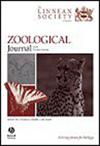Use of traditional tools and micro-computed tomography for the taxonomy of carnivorous bivalves from the deep waters of Southwestern Atlantic
IF 2.8
2区 生物学
Q1 ZOOLOGY
引用次数: 0
Abstract
In this study, we conduct a morphological integrative analysis, using traditional techniques and micro-computed tomography imaging, on Septibranchia species. Specimens deposited in malacological collections and samples collected aboard the research vessels Puerto Deseado and Austral off Mar del Plata (~36°S), San Jorge Gulf (~46°), and Marine Protected Area Namuncurá/Burdwood Bank area (~54°S), at depths ranging from 200 to 3000 m, are the subjects of this study. Seven species were identified, including Cardiomya cleryana (d’Orbigny, 1846), Cardiomya knudseni (Allen & Morgan, 1981), Lyonsiella cf. fragilis Allen & Turner, 1974, and Cetoconcha spinulosa (Thiele, 1912), previously found in the study area. Cardiomya fragilissima (E. A. Smith, 1885), an Antarctic/sub-Antarctic species, extends its distribution up to 36°S. Two new species, Cetoconcha gigas sp. nov. and Lyonsiella tentaculata sp. nov., are described. A lectotype is designated for Pholadomya adelaidis Hedley, 1916 and a neotype for Sphenia cleryana d’Orbigny, 1846. A detailed description of the morphological characters of each species and genus, along with insights into their geographical and bathymetric distribution, are provided. The micro-computed tomography analysis of Cardiomya cleryana, Cardiomya fragilissima, and Cetoconcha spinulosa contributed to a detailed anatomical inspection and revealed the presence of muscle bundles associated with the anterior portion of the visceral mass in the scanned specimens.利用传统工具和微型计算机断层扫描技术对西南大西洋深海水域的食肉双壳类动物进行分类
在本研究中,我们利用传统技术和微型计算机断层扫描成像技术,对七鳃鳗物种进行了形态学综合分析。本研究的对象是在马德普拉塔(南纬约 36°)、圣豪尔赫湾(南纬约 46°)和海洋保护区 Namuncurá/Burdwood Bank 地区(南纬约 54°)水深 200 米至 3000 米的水域中,由研究船 Puerto Deseado 号和 Austral 号采集的沉积在孔雀鱼学藏品中的标本和样本。确定了 7 个物种,包括之前在研究区域发现的 Cardiomya cleryana (d'Orbigny, 1846)、Cardiomya knudseni (Allen & Morgan, 1981)、Lyonsiella cf. fragilis Allen & Turner, 1974 和 Cetoconcha spinulosa (Thiele, 1912)。Cardiomya fragilissima(E. A. Smith,1885 年)是南极/亚南极的一个物种,其分布范围扩大到南纬 36 度。描述了两个新物种,Cetoconcha gigas sp.为 Pholadomya adelaidis Hedley, 1916 指定了一个标准模式,为 Sphenia cleryana d'Orbigny, 1846 指定了一个新模式。报告详细描述了每种和每属的形态特征,并深入分析了它们的地理分布和水深分布。Cardiomya cleryana、Cardiomya fragilissima 和 Cetoconcha spinulosa 的显微计算机断层扫描分析有助于进行详细的解剖学检查,并发现扫描标本中存在与内脏肿块前部相关的肌肉束。
本文章由计算机程序翻译,如有差异,请以英文原文为准。
求助全文
约1分钟内获得全文
求助全文
来源期刊
CiteScore
6.50
自引率
10.70%
发文量
116
审稿时长
6-12 weeks
期刊介绍:
The Zoological Journal of the Linnean Society publishes papers on systematic and evolutionary zoology and comparative, functional and other studies where relevant to these areas. Studies of extinct as well as living animals are included. Reviews are also published; these may be invited by the Editorial Board, but uninvited reviews may also be considered. The Zoological Journal also has a wide circulation amongst zoologists and although narrowly specialized papers are not excluded, potential authors should bear that readership in mind.

 求助内容:
求助内容: 应助结果提醒方式:
应助结果提醒方式:


